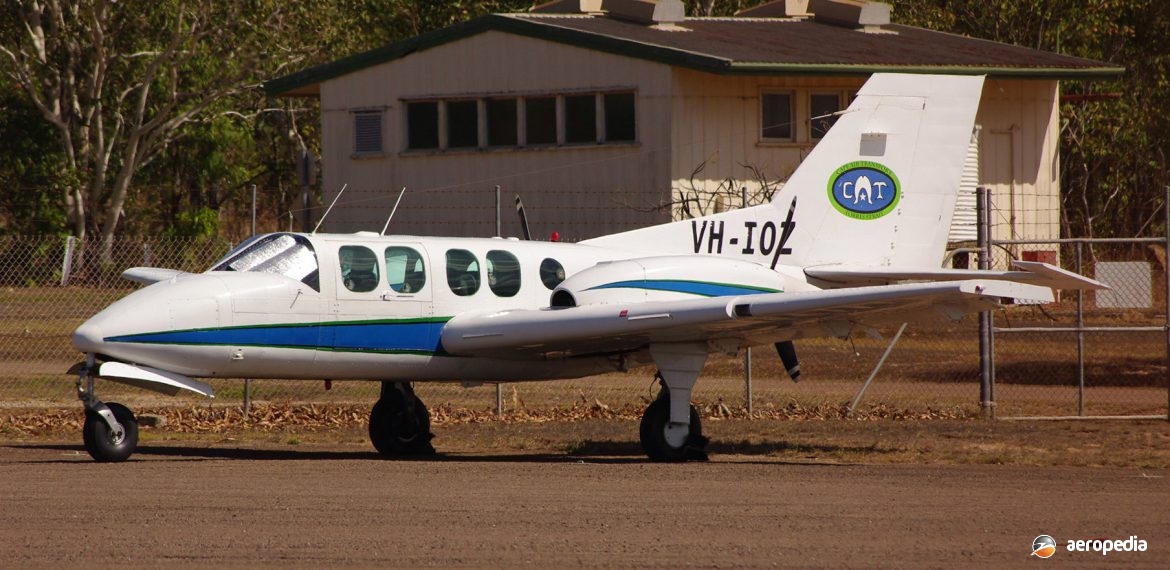Photograph:
Angel Aircraft Angel VH-IOZ (c/n 004) at Horn Island, QLD (David C Eyre)
Country of origin:
United States of America
Description:
Light twin-engine transport
Power Plant:
Two 224 kw (300 hp) Lycoming IO-540 six-cylinder horizontally-opposed air-cooled engines
Specifications:
- Wingspan: 12.14 m (39 ft 11½ in)
- Length: 10.14 m (33 ft 3 in)
- Height: 3.53 m (11 ft 6 in)
- Wing area: 20.93 m² (225.4 sq ft)
- Max speed: 333 km/h (207 mph)
- Cruising speed at 75% power: 324 km/h (201 mph)
- Cruising speed at 45% power: 269 km/h (167 mph)
- Range at 75% power: 2,106 km (1,309 miles)
- Range at 45% power: 2,765 km (1,718 miles)
- Best rate of climb: 405 m/min (1,330 ft/min)
- Service ceiling: 5,796 m (19,015 ft)
- Fuel capacity: 840 litres (185 Imp gals)
- Minimum STOL take-off roll: 201 m (658 ft)
- Landing roll: 173 m (568 ft)
- Empty weight: 1,760 kg (3,880 lb)
- Useful load: 871 kg (1,920 lb)
- Loaded weight: 2,631 kg (5,800 lb)
History:
The Angel was a twin-engine light transport produced in Orange City, Iowa, USA by Angel Aircraft Corporation, fitted with two Lycoming IO-540 engines driving Hartzell propellers in a pusher configuration. The designer, Carl A Mortenson, set up a company which had previously been known as Evangel Aircraft Corporation and built a twin-engine aircraft for missionary work in South America. Design work on the aircraft was carried out by the King’s Engineering Fellowship.
In 2010 the Company was looking for larger premises so it could increase production to 20 aircraft per year. Development led to the Angel, able to seat eight persons. It has been obtained by a number of organisations involved in work in third world countries providing humanitarian relief and missionary work. It has also been aimed at pipeline patrol, search-and-rescue, and personnel transportation work. It was fully IFR equipped and certified to FAR 23, certification being obtained from the FAA in 1992, the Company receiving an FAA Production Certification in 2003. It had some STOL ability and is fitted with a retractable tricycle undercarriage.
The aircraft was of all metal-construction and has been described as simple, reliable and readily repairable, being able to take the punishment associated with STOL operations, being equipped with large, low pressure main tyres for soft ground operations. The aircraft was designed by a team led by Carl Mortenson, who was chief engineer and flight test engineer. It was described as a “sleek comfortable workhorse that offers easy handling, a sizeable payload and endurance”.
Part of the aircraft’s STOL capability related to the almost full-span flaps, spoilers for roll control, and thick aerofoil wing section. The engines were in the pusher configuration and were mounted directly on top of the wings. It had good access to the engines for maintenance due to the low-wing configuration.
First flight was made in January 1984. The aircraft could clear a 15 m (50 ft) obstacle after a 387 m (1,270 ft) roll at max gross weight and in this condition it had a max rate of climb of 434 m/min (1,423 ft/min). The landing run over 15 m (50 ft) was 319 m (1,046 ft).
Simon Mathews Aviation Pty Ltd was noted as the factory-authorised sales representative for Australia and New Zealand in 2005. The first example of the type seen in this region was VH-IOZ² (c/n 004 – ex N1012Q) registered on 8 January 2010 to Milkwood Holdings Pty Ltd and operated by Reach Overseas Inc. In November 2017 VH-IOZ² was owned by Anju Azul Aviation Pty Ltd of Cooktown, QLD, and was operated by Milkwood Holdings Pty Ltd of Mareeba, QLD. In March 2019 the registration was changed to VH-IAZ². However, the aircraft was cancelled from the Civil Aircraft Register and was reported as exported to the United States with the registration N2811W which was noted on the aircraft in June 2018. However, the aircraft as VH-IAZ² crashed and was destroyed at Mareeba on 14 December 2019.
The type was also known as the Angel Model 44 and in 2013 the Chinese company Hubel Taihang Xinghe Aircraft Manufacturing acquired a production licence, the first Chinese- built example being delivered in May that year. Chinese certification of the type has been approved.

